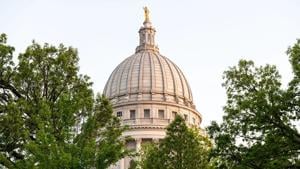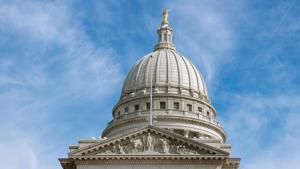No Kings day expected to draw millions for anti-Trump mass protests

Participants joined the No Kings rally in Fargo, North Dakota, on June 14, 2025. (Photo by Erin Hemme Froslie/North Dakota Monitor)
WASHINGTON — More than 2,600 nonviolent demonstrations against President Donald Trump’s administration are slated Saturday as part of No Kings day.
The second No Kings day, following another in June, is in response to what a broad coalition of liberal advocacy and labor organizations say is “the increasing authoritarian excesses and corruption of the Trump administration, which they have doubled down on since June.”

Organizers expect millions of Americans to join in peaceful events in Washington, D.C., across the country and internationally. Locations are pinpointed on a map on the organization’s website.
“No Kings is back,” said Eunic Epstein-Ortiz, a national spokesperson, at a press conference Thursday. “And over the past few months, thousands of people have organized once again in their communities, on the ground locally, volunteering to bring their neighbors, families and friends together to say, unequivocally, we have no kings. Together, they’re the ones making this Saturday’s mobilization the largest single-day protest in modern history.”
Among the states:
- In Utah, Salt Lake City’s No Kings protest organizers canceled the march portion of the event and are instead holding a longer demonstration at the state Capitol, according to the Utah News Dispatch.
- In Maine, at least 30 No Kings events are set to be held, per the Maine Morning Star.
- In Nevada, demonstrators in downtown Las Vegas will again be confined to sidewalks, the Nevada Current reports, citing high permit costs.
- In Kentucky, nearly 30 No Kings protests are popping up in the Bluegrass State, according to the Kentucky Lantern.
- Ten No Kings protests are planned in North Dakota, according to the North Dakota Monitor.
- In Arkansas, the Arkansas Advocate reports that the protests in more than a dozen cities come as the potential for severe weather ratchets up at the same time the events are scheduled.
Shutdown, Trump crackdown since June protests
The demonstrations build off the No Kings protests in June, which coincided with Trump’s massive military parade on his 79th birthday.
Four months later, the federal government is mired in an ongoing shutdown that began Oct. 1 with no clear end in sight. The administration has also cracked down on U.S. cities, deploying National Guard troops and partaking in sweeping immigration raids.
Leading voices from labor and advocacy groups that are part of the broad No Kings coalition amplified their message ahead of the planned protests during the Thursday press conference, underscoring a peaceful day of action on Saturday.
“We’re going to vigorously exercise our democratic rights peacefully and nonviolently, and against this tyrannical threat of Donald Trump and his administration, we are going to protect American democracy,” said Robert Weissman, co-president of Public Citizen.
House speaker criticizes No Kings day
National leaders from the coalition also pushed back against U.S. House Speaker Mike Johnson’s depiction of the demonstrations as the “hate America rally.”

The Louisiana Republican claimed on Fox News Oct. 10 that “it’s all the pro-Hamas wing and the antifa people — they’re all coming out,” adding: “Some of the House Democrats are selling T-shirts for the event, and it’s being told to us that they won’t be able to reopen the government until after that rally because they can’t face their rabid base.”
Leah Greenberg, co-founder of Indivisible, said “there is nothing more American than saying that we don’t have kings and exercising our right to peaceful protest,” adding: “America doesn’t have kings. That’s our entire point.”
Greenberg said: “I also want to be clear: it is ridiculous, it’s also sinister, because it is part of a broader effort to create a permission structure to crack down on organized opposition and peaceful dissent in this country.
“They are sending the National Guard into American cities, they are terrorizing our immigrant friends and neighbors with their secret police, they are prosecuting political opponents, and now they are trying to smear millions of Americans who are coming out to protest so that they can justify a crackdown on peaceful dissent.”
Katie Bethell, executive director of MoveOn, said “let’s be crystal clear about who is peacefully taking the streets on Saturday — it’s teachers, federal workers, nurses, families, our neighbors and our friends.
“All of our leaders, Republicans and Democrats alike, should listen to what these patriotic Americans have to say,” Bethell said.
“The millions of people protesting are centered around a fierce love of our country, a country that we believe is worth fighting for,” she said. “This is the reality across cities and towns, large and small, rural and suburban, in red areas, blue areas — millions of us are peacefully coming together on Saturday to send a clear and unmistakable message: The power belongs to the people.”
In other states:
- The Ohio Capital Journal noted dozens of No Kings protests set to take place in the Buckeye State.
- About 40 No Kings protests are planned in Indiana, according to the Indiana Capital Chronicle.
- Rhode Island is expected to see at least 10 No Kings protests, according to the Rhode Island Current.
- More than 100 communities across Michigan plan to hold No Kings rallies, the Michigan Advance reports.
- In Arizona — where more than 60 No Kings protests are anticipated — high turnout is expected even in the state’s rural Republican strongholds, according to the Arizona Mirror.




















